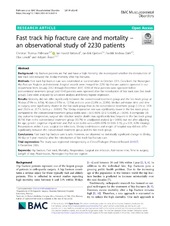| dc.contributor.author | Pollmann, Christian Thomas | en_US |
| dc.contributor.author | Røtterud, Jan H | en_US |
| dc.contributor.author | Gjertsen, Jan-Erik | en_US |
| dc.contributor.author | Dahl, Fredrik Andreas | en_US |
| dc.contributor.author | Lenvik, Olav | en_US |
| dc.contributor.author | Årøen, Asbjørn | en_US |
| dc.date.accessioned | 2020-05-25T17:19:06Z | |
| dc.date.available | 2020-05-25T17:19:06Z | |
| dc.date.issued | 2019-05-24 | |
| dc.Published | Pollmann C, Røtterud JH, Gjertsen JE, Dahl FA, Lenvik, Årøen A. Fast track hip fracture care and mortality – an observational study of 2230 patients. BMC Musculoskeletal Disorders. 2019;20:248 | eng |
| dc.identifier.issn | 1471-2474 | |
| dc.identifier.uri | https://hdl.handle.net/1956/22378 | |
| dc.description.abstract | Background: Hip fracture patients are frail and have a high mortality. We investigated whether the introduction of fast track care reduced the 30-day mortality after hip fractures. Methods: Fast track hip fracture care was established at our institution in October 2013. Data from the Norwegian Hip Fracture Register and electronic hospital records were merged for 2230 hip fracture patients operated in our department from January 2012 through December 2015. 1090 of these patients were operated before (conventional treatment group) and 1140 patients were operated after the introduction of fast track care (fast track group). Data were analysed by univariate analysis and binary logistic regression. Results: Mortality did not differ significantly between the conventional treatment group and the fast track group at 30 days (7.9% vs. 6.5%), 90 days (13.5% vs. 12.5%) and one year (22.8% vs. 22.8%). Median admission time and time to surgery were significantly shorter in the fast track group than in the conventional treatment group (1.1 h vs. 3.9 h and 23.6 h vs. 25.7 h, both p < 0.0001). The 30-day reoperation rate was significantly lower in the fast track group compared to the conventional treatment group (odds ratio = 0.35 (95% CI: 0.15–0.84), p = 0.019). A composite 30-day outcome (reoperation, surgical site infection and/or death) was significantly less frequent in the fast track group (8.1%) than in the conventional treatment group (10.7%) in unadjusted analysis (p = 0.006), but not after adjusting for age, gender, cognitive impairment and ASA score (odds ratio = 0.85 (95% CI: 0.63–1.16), p = 0.31, 8.0% missing). Reoperations within 1 year, surgical site infections, 30-day readmissions and length of hospital stay did not differ significantly between the conventional treatment group and the fast track group. Conclusions: Fast track hip fracture care is safe. However, we observed no statistically significant change in 30-day, 90-day or 1-year mortality after the introduction of fast track hip fracture care. | en_US |
| dc.language.iso | eng | eng |
| dc.publisher | BMC | eng |
| dc.rights | Attribution CC BY | eng |
| dc.rights.uri | http://creativecommons.org/licenses/by/4.0/ | eng |
| dc.subject | Hip fracture | eng |
| dc.subject | Fast track | eng |
| dc.subject | Mortality | eng |
| dc.subject | Reoperation | eng |
| dc.subject | Surgical site infection | eng |
| dc.subject | Admission time | eng |
| dc.subject | Time to surgery | eng |
| dc.subject | Length of stay | eng |
| dc.subject | Readmission | eng |
| dc.subject | Norwegian hip fracture register | eng |
| dc.title | Fast track hip fracture care and mortality – an observational study of 2230 patients | en_US |
| dc.type | Peer reviewed | |
| dc.type | Journal article | |
| dc.date.updated | 2019-12-30T16:00:04Z | |
| dc.description.version | publishedVersion | en_US |
| dc.rights.holder | Copyright 2019 The Author(s) | |
| dc.identifier.doi | https://doi.org/10.1186/s12891-019-2637-6 | |
| dc.identifier.cristin | 1700539 | |
| dc.source.journal | BMC Musculoskeletal Disorders | |

